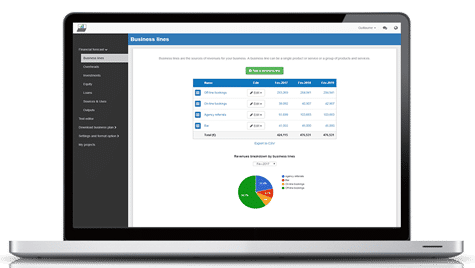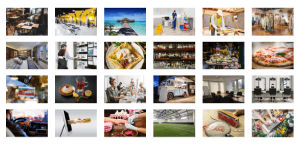How to create a financial forecast for a seafood restaurant?
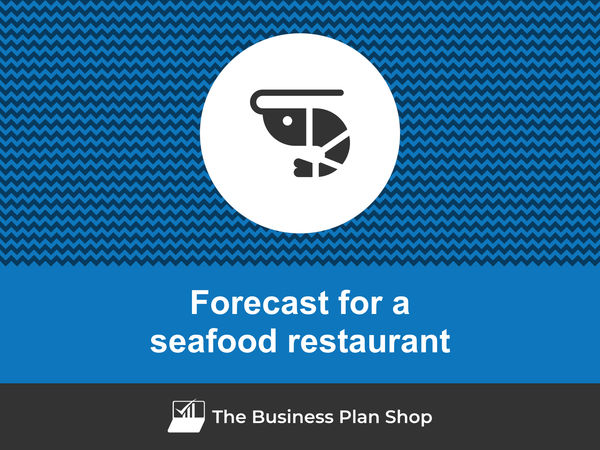
If you are serious about keeping visibility on your future cash flows, then you need to build and maintain a financial forecast for your seafood restaurant.
Putting together a seafood restaurant financial forecast may sound complex, but don’t worry, with the right tool, it’s easier than it looks, and The Business Plan Shop is here to guide you.
In this practical guide, we'll cover everything you need to know about building financial projections for your seafood restaurant.
We will start by looking at why they are key, what information is needed, what a forecast looks like once completed, and what solutions you can use to create yours.
Let's dive in!
Why create and maintain a financial forecast for a seafood restaurant?
The financial projections for your seafood restaurant act as a financial blueprint to guide its growth with confidence and ensure its long-term financial viability.
To create them, you will need to look at your business in detail - from sales to operating costs and investments - to assess how much profit it can generate in the years to come and what will be the associated cash flows.
During challenging market conditions, maintaining an up-to-date financial forecast enables early detection of potential financial shortfalls, allowing for timely adjustments or securing financing before facing a cash crisis.
Your seafood restaurant's financial forecast will also prove invaluable when seeking financing. Banks and investors will undoubtedly request a thorough examination of your financial figures, making precision and presentation essential.
Need a solid financial forecast?
The Business Plan Shop does the maths for you. Simply enter your revenues, costs and investments. Click save and our online tool builds a three-way forecast for you instantly.
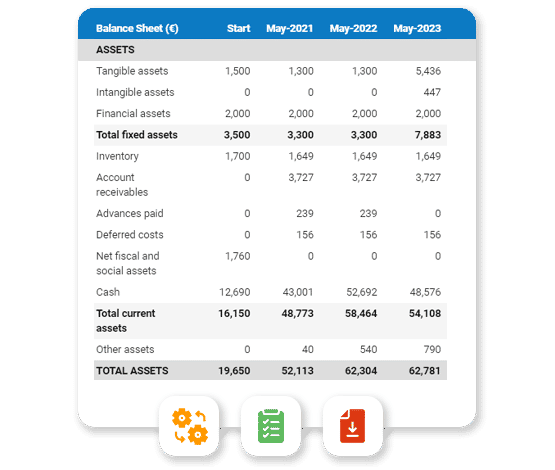
What information is used as input to build a seafood restaurant financial forecast?
A seafood restaurant's financial forecast needs to be built on the right foundation: your assumptions.
The data required to create your assumptions will depend on whether you are a new or existing seafood restaurant.
If you are creating (or updating) the forecast of an existing seafood restaurant, then your main inputs will be historical accounting data and operating metrics, and your team’s view on what to expect for the next three to five years.
If you are building financial projections for a new seafood restaurant startup, you will need to rely on market research to form your go-to-market strategy and derive your sales forecast.
For a new venture, you will also need an itemised list of resources needed for the seafood restaurant to operate, along with a list of equipment required to launch the venture (more on that below).
Now that you understand what is needed, let’s have a look at what elements will make up your seafood restaurant's financial forecast.
The sales forecast for a seafood restaurant
The sales forecast, also called topline projection, is normally where you will start when building your seafood restaurant financial forecast.
Creating a coherent sales projection boils down to estimating two key drivers:
- The average price
- The number of monthly transactions
To do this, you will need to rely on historical data (for an existing business), market research data (for both new and existing seafood restaurants), and consider the elements below:
- Seasonal Availability of Seafood: As a seafood restaurant, the availability of certain types of seafood can greatly impact your average price and number of monthly transactions. For example, if a particular type of seafood is not in season, it may be more expensive to source, causing your average price to increase and potentially leading to a decrease in transactions as customers may opt for less expensive options.
- Sustainability Practices: With increasing awareness and concern for the environment, customers are becoming more conscious of the sustainability practices of restaurants. As a seafood restaurant, your sustainability practices can greatly impact your average price and number of monthly transactions. For instance, if you source your seafood from sustainable and ethical sources, you may be able to charge a premium price and attract more customers.
- Competition: The level of competition in your area can also affect your average price and number of monthly transactions. If you are in a highly competitive market with many other seafood restaurants, you may need to lower your prices to remain competitive and attract customers. On the other hand, if you are in a less competitive market, you may be able to charge higher prices and see an increase in transactions.
- Tourist Season: If your seafood restaurant is located in a popular tourist destination, the tourist season can greatly impact your sales. During peak tourist season, your average price may increase as demand for seafood rises, but you may also see a decrease in transactions if there is a limited supply of seafood. On the other hand, during the off-season, your average price may decrease as there is less demand, but you may see an increase in transactions.
- Economic Conditions: Economic conditions, such as a recession or inflation, can also affect your average price and number of monthly transactions. During a recession, customers may be more price-sensitive and opt for less expensive menu options, causing your average price to decrease. Inflation, on the other hand, may lead to an increase in your average price as the cost of seafood and other ingredients rises.
After the sales forecast comes the operating expenses budget, which we will now look into in more detail.
Need inspiration for your business plan?
The Business Plan Shop has dozens of business plan templates that you can use to get a clear idea of what a complete business plan looks like.
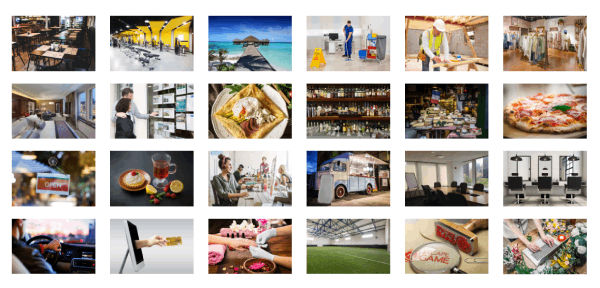
The operating expenses for a seafood restaurant
Once you know what level of sales you can expect, you can start budgeting the expenses required to operate your seafood restaurant on a daily basis.
Expenses normally vary based on how much revenue you anticipate (which is why, from experience, it is always better to start your forecast with the topline projection), and where your business is based.
Operating expenses for a seafood restaurant will include some of the following items:
- Staff costs: This includes salaries, wages, and benefits for your employees. In a seafood restaurant, you may also need to budget for additional seafood-specific training for your staff.
- Food and beverage costs: This includes the cost of purchasing seafood and other ingredients for your menu items, as well as any beverages you serve.
- Rent or lease: You will need to budget for the cost of renting or leasing your restaurant space, whether it is a standalone building or part of a larger complex.
- Utilities: This includes electricity, gas, water, and other utilities necessary to operate your restaurant.
- Equipment and supplies: You will need to purchase equipment specific to a seafood restaurant, such as seafood processing tools, as well as general restaurant supplies like plates, utensils, and linens.
- Marketing and advertising: You will need to promote your seafood restaurant to attract customers, so budget for expenses such as advertising, website maintenance, and social media management.
- Accountancy fees: You may need to hire an accountant to assist with tax preparation and financial planning for your seafood restaurant.
- Insurance costs: It is important to have insurance coverage for your restaurant, including liability insurance and property insurance.
- Software licenses: You may need to purchase software for your point-of-sale system, inventory management, and other back-office functions.
- Professional fees: You may need to hire a lawyer or consultant for legal or business advice related to your seafood restaurant.
- Banking fees: This includes fees for processing credit card payments, as well as any fees associated with business banking accounts.
- Cleaning and maintenance: A seafood restaurant requires regular cleaning and maintenance to ensure food safety and a pleasant dining atmosphere.
- Employee benefits: In addition to salaries and wages, you may also need to budget for employee benefits such as health insurance, retirement plans, and paid time off.
- Liquor license: If your seafood restaurant serves alcohol, you will need to budget for the cost of obtaining and renewing a liquor license.
- Taxes and permits: You will need to pay various taxes, such as sales tax and payroll taxes, as well as obtain necessary permits for your seafood restaurant.
This list will need to be tailored to the specificities of your seafood restaurant, but should offer a good starting point for your budget.
What investments are needed to start or grow a seafood restaurant?
Once you have an idea of how much sales you could achieve and what it will cost to run your seafood restaurant, it is time to look into the equipment required to launch or expand the activity.
For a seafood restaurant, capital expenditures and initial working capital items could include:
- Kitchen Equipment: This includes items such as commercial refrigerators, ovens, fryers, and other specialized equipment needed to prepare and store seafood dishes.
- Furniture and Fixtures: This includes tables, chairs, countertops, and other necessary fixtures to create a comfortable and functional dining space for your customers.
- Point of Sale System: A modern and efficient POS system is essential for a seafood restaurant, allowing you to track sales, manage inventory, and process payments seamlessly.
- Seafood Display Case: If your restaurant offers fresh seafood for purchase, investing in a high-quality and visually appealing display case can help attract customers and showcase your products.
- Bar Equipment: If your seafood restaurant has a bar, you will need to invest in items such as a bar counter, stools, and a variety of bar equipment to serve drinks and cocktails to your customers.
Again, this list will need to be adjusted according to the specificities of your seafood restaurant.
Need a convincing business plan?
The Business Plan Shop makes it easy to create a financial forecast to assess the potential profitability of your projects, and write a business plan that’ll wow investors.
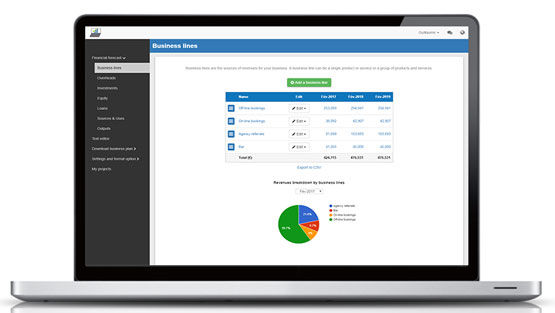
The financing plan of your seafood restaurant
The next step in the creation of your financial forecast for your seafood restaurant is to think about how you might finance your business.
You will have to assess how much capital will come from shareholders (equity) and how much can be secured through banks.
Bank loans will have to be modelled so that you can separate the interest expenses from the repayments of principal, and include all this data in your forecast.
Issuing share capital and obtaining a bank loan are two of the most common ways that entrepreneurs finance their businesses.
What tables compose the financial plan for a seafood restaurant?
Now let's have a look at the main output tables of your seafood restaurant's financial forecast.
The projected profit & loss statement
The projected profit & loss shows how profitable your seafood restaurant is likely to be in the years to come.

For your seafood restaurant to be financially viable, your projected P&L should ideally show:
- Sales growing above inflation (the higher the better)
- Profit margins which are stable or expanding (the higher the better)
- A net profit at the end of each financial year (the higher the better)
This is for established seafood restaurants, there is some leniency for startups which will have numbers that will look a bit different than existing businesses.
The projected balance sheet
The projected balance sheet gives an overview of your seafood restaurant's financial structure at the end of the financial year.
It is composed of three categories of items: assets, liabilities and equity:
- Assets: are what the business possesses and uses to produce cash flows. It includes resources such as cash, buildings, equipment, and accounts receivable (money owed by clients).
- Liabilities: are the debts of your seafood restaurant. They include accounts payable (money owed to suppliers), taxes due and bank loans.
- Equity: is the combination of what has been invested by the business owners and the cumulative profits to date (which are called retained earnings). Equity is a proxy for the value of the owner's stake in the business.
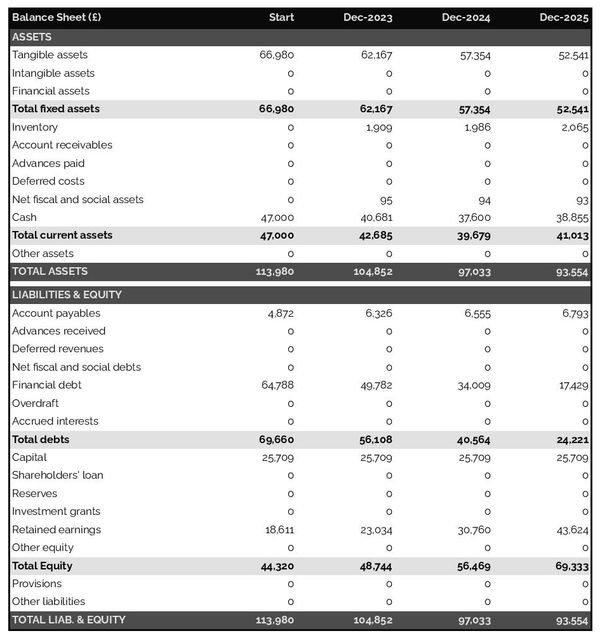
The projected cash flow statement
A projected cash flow statement for a seafood restaurant is used to show how much cash the business is generating or consuming.
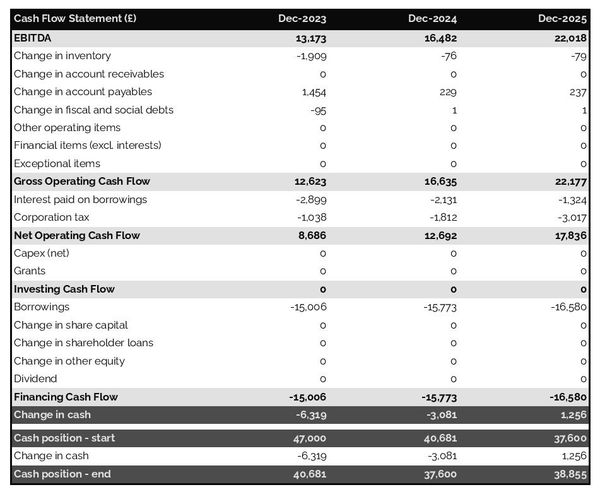
The cash flow forecast is usually organised by nature to show three key metrics:
- The operating cash flow: do the core business activities generate or consume cash?
- The investing cash flow: how much is the business investing in long-term assets (this is usually compared to the level of fixed assets on the balance sheet to assess whether the business is regularly maintaining and renewing its equipment)?
- The financing cash flow: is the business raising new financing or repaying financiers (debt repayment, dividends)?
Cash is king and keeping an eye on future cash flows is imperative for running a successful business. Therefore, you should pay close attention to your seafood restaurant's cash flow forecast.
If you are trying to secure financing, note that it is customary to provide both yearly and monthly cash flow forecasts in a financial plan - so that the reader can analyze seasonal variation and ensure the seafood restaurant is appropriately capitalised.
Need a solid financial forecast?
The Business Plan Shop does the maths for you. Simply enter your revenues, costs and investments. Click save and our online tool builds a three-way forecast for you instantly.

Which tool should you use to create your seafood restaurant's financial forecast?
Using the right tool or solution will make the creation of your seafood restaurant's financial forecast much easier than it sounds. Let’s explore the main options.
Using online financial forecasting software to build your seafood restaurant's projections
The modern and easiest way is to use an online financial forecasting tool such as the one we offer at The Business Plan Shop.
There are several advantages to using specialised software:
- You can easily create your financial forecast by letting the software take care of the financial calculations for you without errors
- You have access to complete financial forecast templates
- You get a complete financial forecast ready to be sent to your bank or investors
- You can easily track your actual financial performance against your financial forecast, and recalibrate your forecast as the year goes by
- You can create scenarios to stress test your forecast's main assumptions
- You can easily update your forecast as time goes by to maintain visibility on future cash flows
- You have a friendly support team on standby to assist you when you are stuck
- It’s cost-efficient and much cheaper than using an accountant or consultant (see below)
If you are interested in this type of solution, you can try our projection software for free by signing up here.
Hiring a financial consultant or chartered accountant
Hiring a consultant or chartered accountant is also an efficient way to get a professional seafood restaurant financial projection.
As you can imagine, this solution is much more expensive than using software. From experience, the creation of a simple financial forecast over three years (including a balance sheet, income statement, and cash flow statement) is likely to start around £700 or $1,000 excluding taxes.
The indicative estimate above, is for a small business, and a forecast done as a one-off. Using a financial consultant or accountant to track your actuals vs. forecast and to keep your financial forecast up to date on a monthly or quarterly basis will naturally cost a lot more.
If you choose this solution, make sure your service provider has first-hand experience in your industry, so that they may challenge your assumptions and offer insights (as opposed to just taking your figures at face value to create the forecast’s financial statements).
Why not use a spreadsheet such as Excel or Google Sheets to build your seafood restaurant's financial forecast?
Creating an accurate and error-free seafood restaurant financial forecast with a spreadsheet is very technical and requires a deep knowledge of accounting and an understanding of financial modelling.
Very few business owners are financially savvy enough to be able to build a forecast themselves on Excel without making mistakes.
Lenders and investors know this, which is why forecasts created on Excel by the business owner are often frowned upon.
Having numbers one can trust is key when it comes to financial forecasting and to that end using software is much safer.
Using financial forecasting software is also faster than using a spreadsheet, and, with the rise of artificial intelligence, software is also becoming smarter at helping us analyse the numbers to make smarter decisions.
Finally, like everything with spreadsheets, tracking actuals vs. forecasts and keeping your projections up to date as the year progresses is manual, tedious, and error-prone. Whereas financial projection software like The Business Plan Shop is built for this.
Need a convincing business plan?
The Business Plan Shop makes it easy to create a financial forecast to assess the potential profitability of your projects, and write a business plan that’ll wow investors.

Use our financial projection templates for inspiration
The Business Plan Shop has dozens of financial forecast templates available.
Our examples contain a complete business plan with a financial forecast and a written presentation of the company, the team, the strategy, and the medium-term objectives.
Whether you are just starting out or already have your own seafood restaurant, looking at our financial forecast template is a good way to:
- Understand what a complete business plan should look like
- Understand how you should model financial items for your seafood restaurant
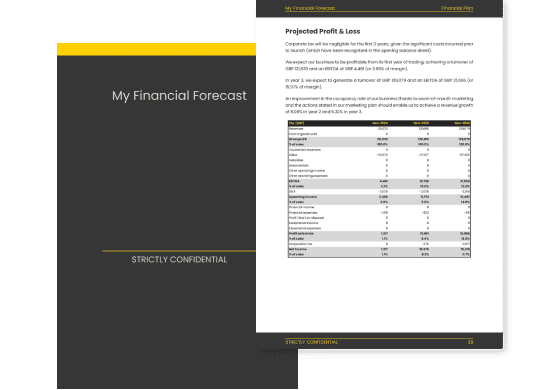
Takeaways
- A financial projection shows expected growth, profitability, and cash generation for your business over the next three to five years.
- Tracking actuals vs. forecast and keeping your financial forecast up-to-date is the only way to maintain visibility on future cash flows.
- Using financial forecasting software makes it easy to create and maintain up-to-date projections for your seafood restaurant.
You have reached the end of our guide. We hope you now have a better understanding of how to create a financial forecast for a seafood restaurant. Don't hesitate to contact our team if you have any questions or want to share your experience building forecasts!
Need inspiration for your business plan?
The Business Plan Shop has dozens of business plan templates that you can use to get a clear idea of what a complete business plan looks like.

Also on The Business Plan Shop
Know someone who runs or wants to start a seafood restaurant? Share our financial projection guide with them!

